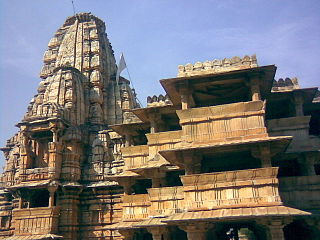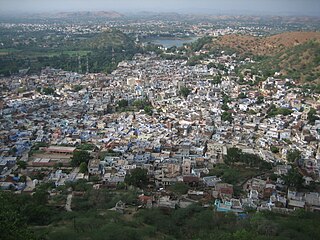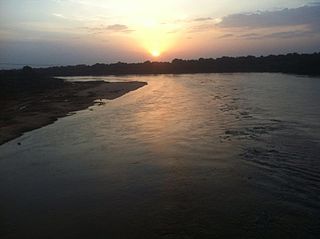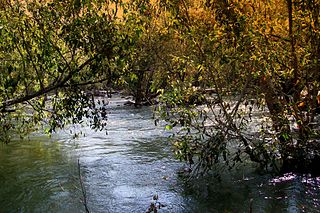Related Research Articles
Banswara is a town in the Banswara district in southern Rajasthan, India. The name, Banswara, came from king ‘Bansiya Bhil’

Kashi Vishwanath Temple is a Hindu temple dedicated to Shiva. It is located in Vishwanath Gali, in Varanasi, Uttar Pradesh, India. The temple is a Hindu pilgrimage site and is one of the twelve Jyotirlinga shrines. The presiding deity is known by the names Vishwanath and Vishweshwara, literally meaning Lord of the Universe.

Vagad is a region in southeastern Rajasthan state of western India. Its boundaries are roughly defined by those of the districts of Dungarpur and Banswara. Major cities of the region are Dungarpur and Banswara.

Dungarpur is a city in the southernmost part of Rajasthan, India. It is the administrative headquarters of Dungarpur District. It is the fastest developing town in the southern part of Rajasthan, alongside Aspur tehsil.

Banswara District has an area of 5,037 km2 (1,945 sq mi), which is 1.47% of Rajasthan state, India. The city of Banswara is the district headquarters. It is bounded on the north by Udaipur District, on the northeast by Pratapgarh District, on the east and southeast by Madhya Pradesh state, on the southwest by Gujarat state, and on the west by Dungarpur District.

Udaipur district is one of the 50 districts of Rajasthan state in western India. The historic city of Udaipur is the administrative headquarters of the district. The district is part of the Mewar region of Rajasthan.

Dungarpur District is a district of the state of Rajasthan in western India. The town of Dungarpur is the district headquarters.
Kherwara Chhaoni is a census town in the Udaipur district in the Indian state of Rajasthan. It is part of the Vagad region, which includes the districts of Dungarpur, Banswara and parts of Udaipur district. It is in close proximity to two major highways, National Highway 8 and Rajasthan State Highway 76 and National Highway 927A passes through it. Its name derives from the large number of Kher (Khair) trees in the region in the past.
Rikhabdeo ( Rishabhadeo) is a town in Udaipur district in the state of Rajasthan, in north-west India.

Bhogilal Pandya (1904-1981) was a freedom fighter and social worker from Dungarpur in the Indian state of Rajasthan. On 3 April 1976, the Government of India awarded him the Padma Bhushan for his social services. The Padma Bhushan is the third-highest civilian award in the Republic of India, given for distinguished service to the nation. For his championing of education and rights for the poor and underprivileged, he is referred by the people of Rajasthan as "Gandhi of Vahgad". His home is in the Gandhi aashram area of Dungarpur.
The culture of Gujarat is both ancient, new, and modern.

Birla Mandir, Jaipur is a Hindu temple located in Jaipur, India and is one of many Birla mandirs. It was built by the B.M. Birla Foundation in 1988 and is constructed solely of white marble. It is dedicated to the Hindu goddess and Lakshmi and god Vishnu (Narayan), whose images appear inside, along with other Hindu gods and goddesses and selections from the Gita and Upanishads. It is located in Jaipur's Tilak Nagar neighborhood near Moti Dungari hill.

Rajasthan is one of the most popular tourist destinations in India, for both domestic and international tourists. Rajasthan attracts tourists for its historical forts, palaces, art and culture with its slogan "Padharo Mhare Desh " The capital city, Jaipur, also known as Pink City, is a very popular tourist destination and is a part of the Golden Triangle. The Walled City of Jaipur is only the second Indian city to be recognized as a UNESCO World Heritage Site, after Ahmedabad.

Parshuram Mahadev Temple is a cave Shiva temple located at border of Pali district and Rajsamand district of Rajasthan state in India. The main cave temple comes in Rajsamand district, whereas Kund Dham comes in Desuri Tehsil of Pali district. It is about 100 km away from Pali and only 10 km from famous Kumbhalgarh fort. The place is 14 km from Sadri town and 160km from Jodhpur. Access from lower altitude Sadri side is easier; however, access from Kumbhalgarh, Rajsamand, Nathdwara or Udaipur involves a little trekking downhill from a place designated as parking for the temple. There are 500 stairs to reach the ancient cave from Sadri side.

Prabodhini Ekadashi, also known as Deva Uttana Ekadashi, is the 11th lunar day (ekadashi) in the bright fortnight of the Hindu month of Kartika. It marks the end of the four-month period of Chaturmasya, when the god Vishnu is believed to be asleep. It is believed that Vishnu sleeps on the day of Shayani Ekadashi, and wakes on this day.
Peepal Khoont mainly known as Pipalkhunt is a village, Tehsil headquarter and Panchayat Samiti of the Pratapgarh district of Rajasthan state. It is a sub-division among the 5 sub-divisions of the Pratapgarh district. The main market is called Sadar Bajar. It is situated on National Highway 113. Pipalkhunt is a town located on the Banswara - Jaipur Expressway surrounded by the hills, plants and trees. The town is situated on the bank of the Mahi River.
Simalwara is a census town in Dungarpur district in the Indian state of Rajasthan. It is the administrative headquarters for Simalwara Tehsil.

The Vatrak is a tributary of the Sabarmati River which flows for 243 kilometers in Gujarat, India. It originates in the hills of Dungarpur, Rajasthan and enters in Gujarat near village Moydi of Meghraj taluka.

Jākham River is a stream located in Pratapgarh district Rajasthan, India. It has an elevation of approximately 112 meters above sea level. It is a tributary of the Som River, flowing into the latter on the border between Udaipur and Dungarpur districts.